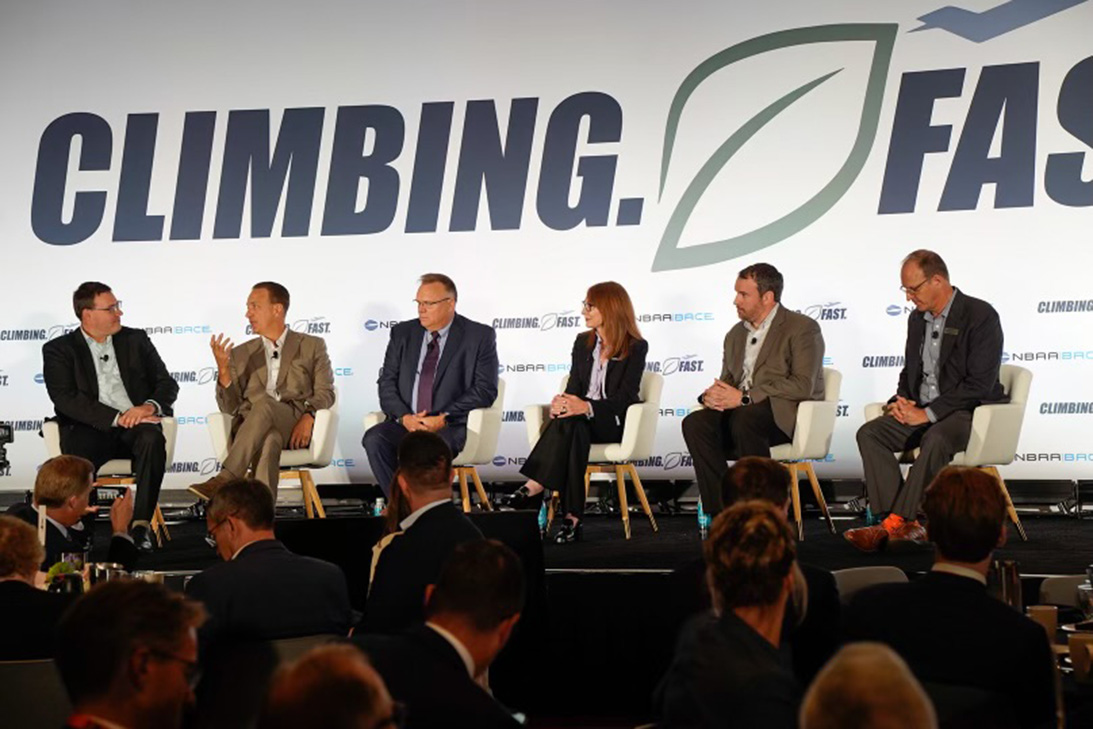NBAA-BACE Newsmakers Lunch: Hybrid Electric Aircraft Coming Soon

Oct. 17, 2023
Industry visionaries leading the development of hybrid and electric aircraft propulsion joined the FAA’s head of aviation safety for a Newsmakers Lunch panel on the opening day of the 2023 NBAA Business Aviation Convention & Exhibition (NBAA-BACE) in Las Vegas.
Topics such as fuel systems, regulation and markets dominated the lively discussion where hybrid electric aircraft developers like Jean Botti, CEO and CTO of France-based VoltAero, made a strong case for having two fuel sources.
“It’s probably better to be able to use two fuels to start with – what you have today, plus electric, this is already a step. Second, in order to make sure you have safety, two sources of energy [batteries and electric generators] are always better than one and much better for noise reasons,” said Botti, whose company is currently developing the Cassio family of electric-hybrid powered aircraft.
Business aviation leaders have expressed support for the emerging AAM sector, and many experts believe electric powered aircraft platforms will be critical to achieving the industry goal of reaching net-zero carbon emissions by 2050.
Depending on the length of the certification process, some of these aircraft under development could be in service as soon as 2025.
“For next 20 or 30 years, hybrid electric will be the primary bulk of flights for the regional air mobility market – at least that’s our view,” said Marc Ausman of Electra.aero, a Virginia-based company developing a hybrid electric short takeoff and landing passenger aircraft for regional mobility.
“Now – that said – when battery technology becomes viable, we will have a better electric aircraft,” Ausman explained, because Electra.aero could replace the aircraft’s turbo electric generator with better technology once it eventually proves itself. Electra.aero’s fixed wing design for short landings and takeoffs is “future proofed and commercially viable today,” he said.
“There’s unequivocally going to be a position for hybrid in this market. It’s going to happen. It makes a lot of economic sense and technological sense,” said aerospace engineer Patrick Buckles, chief revenue officer at BETA Technologies, a Vermont-based developer of non-hybrid, battery-powered electric airplanes as well as eVTOL aircraft. “But before we try to bring in other fuel sources, you have to have a very safe, very reliable battery system and you have to have a high performing, high-reliability electric motor.”
Buckles said this moment in history presents an opportunity for OEMs and the FAA to partner more closely. “As we get into a routine where we’re all willing to share data with the FAA and be transparent and learn from each other day-to-day, we would build incredibly safe aircraft that operate in our airspace.”
Misconceptions
Moderator Robin Riedel, who co-leads McKinsey & Company’s Center for Future Mobility, asked panelists to point out some common misconceptions about AAM.
Panelist Kriya Shortt, president and CEO of Textron eAviation, urged people to keep in mind that – although AAM technology is happening now – there’s won’t be a one-size-fits-all solution.
“It’ll continue to evolve and grow, and we just need to be open minded about that. But we need to do that with a pragmatic understanding that there are a lot of different approaches,” Shortt said. “There is a lot of space, and we need to do it with the utmost safety.”
With so many approaches, panelist David Boulter, FAA associate administrator for aviation safety, acknowledged that keeping up with all the various AAM propulsion designs presents “real challenges for a regulator to take on all at once.” To meet these challenges, he said AAM certification has been reorganized. “We’re working across the agency to break down stovepipes.
“You’ll see a big push from us next year to really be out engaged with the applicants, so that we can learn more, and we can make sure that we understand it. and a lot of these technologies will go across products.”
“We are fully engaged in making sure that we don’t stand in the way of innovation because a lot of these innovations are lifesaving,” said Boulter. “They will make it safer.”
Any person who attends an NBAA convention, conference, seminar or other program grants permission to NBAA, its employees and agents (collectively "NBAA") to record his or her visual/audio images, including, but not limited to, photographs, digital images, voices, sound or video recordings, audio clips, or accompanying written descriptions, and, without notifying such person, to use his or her name and such images for any purpose of NBAA, including advertisements for NBAA and its programs.
Related Articles
May/June 2024
How NASA Is Helping to Define the Future of Business Aviation
March/April 2024
FAA’s Top Airport Official Discusses Safety, AAM and Vertiports
Jan/Feb 2024
Dr. Anita Sengupta: Hydrogen Electric Aircraft Are Coming
February 5, 2024


 International Business Aviation Council Ltd.
International Business Aviation Council Ltd.